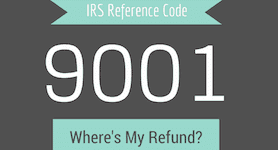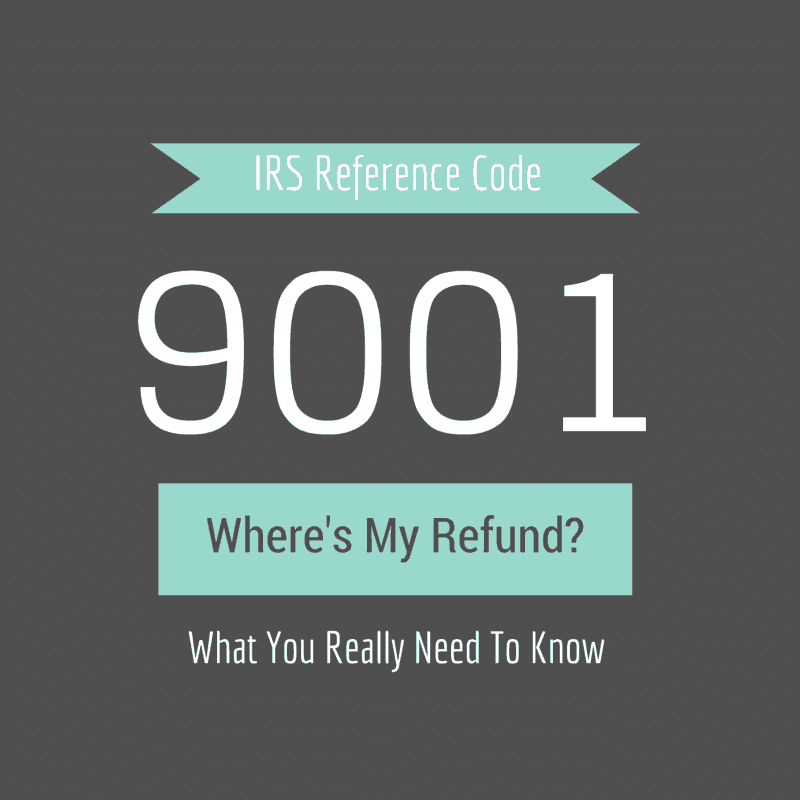
One of the biggest questions we get every tax season is pretty simple: What does IRS Code 9001 Mean? So many tax filers are seeing this code when they are logging in to check their refunds, and it's blowing up the comment section on our article IRS Where's My Refund Reference Codes, and it's also driving multiple emails and Facebook comments.
So, what the heck does IRS Reference Number 9001 really mean? It's actually pretty simple.
IRS Reference Code 9001
IRS Code 9001: “Taxpayer accessed Refund Status using a secondary TIN. Refund Status could not be returned. Get a Primary TIN Analyze account and follow appropriate IRM."
The IRS has an entire manual dedicated to errors and problems that they encounter during the course of doing business. Some of these codes are directly related to your tax return, and some are related to you something else. For the most part, codes less than 2000 are related directly to your return. Anything higher (like code 9001), it's related to something totally different - so right there, stop freaking out.
What IRS Code 9001 Really Means
The actual code tells you exactly what it means - you filed a tax return that had multiple Social Security numbers attached to it. Typically, this is a husband and wife, but it could also include children as well (you never know, adult dependents may be checking the status of the refund). When you file your tax return, you have to specify a primary taxpayer, and the spouse or children all are secondary.
If you login to Where's My Refund or on the IRS App and try to use the secondary Social Security number, you're going to get this error message.
What The IRS Says
The IRS established the “Where’s My Refund?” portal to allow taxpayers to check the status of their federal income tax return and refund. To access the portal you need three pieces of information: your Social Security Number or Taxpayer Identification Number (TIN), your filing status and amount of the refund that you are expecting. This refund amount should be listed in whole dollars and must match the amount listed on your tax forms exactly.
Having code 9001 is not an audit, and it shouldn't concern taxpayers. It just means there was an attempt to access return or refund results using the wrong Social Security number or TIN.
Concerns About Identity Theft
We've seen a lot of people concerned about identity theft this year, and this is a possible flag for it. While the code itself is not an audit flag, we have heard about cases of people trying the wrong Social Security number too many times, and their return was put on hold until their identity could be verified.
So, before you go to WMR and start typing in the secondary Social Security number multiple times, stop, think, pull out a copy of your tax return, and do it the right way. Otherwise, you could see your refund delayed.
Along with that, whenever you call the IRS about your refund, they will check your ID. This is NOT an identity theft check. If you had a real identity theft issue, you would have to verify your identity in person or by submitting an Identity Theft Affidavit. You can learn more about the process here: https://www.irs.gov/uac/Taxpayer-Guide-to-Identity-Theft
What You Need To Do
If you get IRS Code 9001 when you login, in most cases you need to do nothing. In fact, unless you have a really good reason to call the IRS, don't.
First, the IRS is swamped with calls right now, and you could spend hours on the phone for nothing.
Second, if the IRS has a problem with your return, they will send you a letter describing the issue and the next steps. For most situations, you cannot resolve it over the phone with the IRS because of potential identity theft issues.
If you are getting this code and you are 100% positive that you are using the primary SSN, then you should consider calling the IRS or going into your local office. That is the only sign of potential identity theft that we've seen from IRS Reference Number 9001.
Have other questions? Check out our IRS Where's My Refund Questions and Errors FAQ.
Have you received IRS Code 9001 on WMR?

Robert Farrington is America’s Millennial Money Expert® and America’s Student Loan Debt Expert™, and the founder of The College Investor, a personal finance site dedicated to helping millennials escape student loan debt to start investing and building wealth for the future. You can learn more about him on the About Page or on his personal site RobertFarrington.com.
He regularly writes about investing, student loan debt, and general personal finance topics geared toward anyone wanting to earn more, get out of debt, and start building wealth for the future.
He has been quoted in major publications, including the New York Times, Wall Street Journal, Washington Post, ABC, NBC, Today, and more. He is also a regular contributor to Forbes.
Editor: Clint Proctor Reviewed by: Chris Muller
